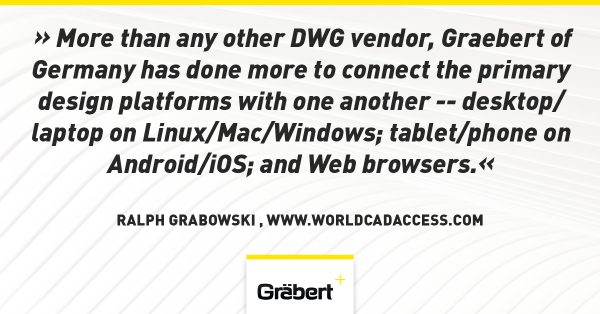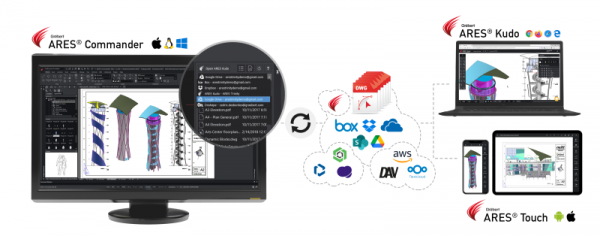Using Asynchronous Communication in CAD
- 19/10/2021
- Posted by: Graebert
- Category: General NewsPress articles


Asynchronous Communication in the ARES Trinity of CAD
More than any other DWG vendor, Graebert of Germany has done more to connect the primary design platforms with one another — desktop/laptop on Linux/Mac/Windows; tablet/phone on Android/iOS; and Web browsers. The name of the company may not be familiar to you, as they tend to sell white label CAD. Companies like Corel, Dassault Systems, and Onshape use Graebert’s “ARES” code for their DWG editors.
Here, business development manager Cedric Desbordes describes how this trifecta of CAD platforms is useful for today’s WFH environment. Asynchronous communication means that all parties don’t have to be online at the same time — this like sending an email, instead of placing a phone call, which is synchronous communication.
What we are achieving with our Trinity workflow is very similar for DWG drawings (files in the cloud, user rights, view-only links, markups and comments, email notifications), but with additional advantages:
Do it your way
For each project, users can decide whether to keep working with local files or to access files from the cloud. Also, it is not required to switch to cloud-based ARES Kudo to benefit from collaboration features, as they are also found in desktop ARES Commander. Users in organizations can go at their pace — there is no abrupt/disruptive transition to new tools or workflows.
Your cloud
In contrast to Google Docs, ARES does not force users to place files on our servers. We recognize that many companies have already made the decision on which cloud storage provider(s) to use. There is no reason to isolate DWG files from other files, so it is just common sense to for ARES to connect to a large number of existing cloud services, as well as provide the WebDAV protocol to connect easily to any other service.
In addition, we partner with AWS for those customers asking for a dedicated infrastructure, as well as to offer some storage with ARES Kudo Drive for users who have nothing in place and so want first to experiment with a few projects on our servers.
Highly secure
Files stay on the servers customers are already using, and ARES is used only to edit them. Our infrastructure is reviewed by the AWS team for security.

I think another key difference with Google Docs is that our industry has a strong need to improve the workflow between the users who are producing drawings at the office (or in home offices) with others in the field needing that technical information while working at a construction site, who are on customer visits, or work at a facility or factory.
Efficient interaction between the two groups requires software with the following capabilities for workers in the field:
- Access any drawing without planning ahead of time which files to take with them
- Always view the latest version of the drawing to avoid mistakes, which cost
- Enrich the project with useful feedback collected in the field to help the users editing drawings to reduce time-to-market
- Email notifications to that allow every user to follow the project updates, and jump into the file promptly when needed
From my perspective, view-only links are the most appealing feature to get new users started with cloud-based workflows. As we offer some free storage with the ARES Kudo Drive, it becomes possible for ARES Commander users to upload one of their files, create a view-only link, and send it to a colleague or customer who can view — and comment or markup — for free.
Read more from a guest editorial by Cedric Desbordes on www.worldcadaccess.com